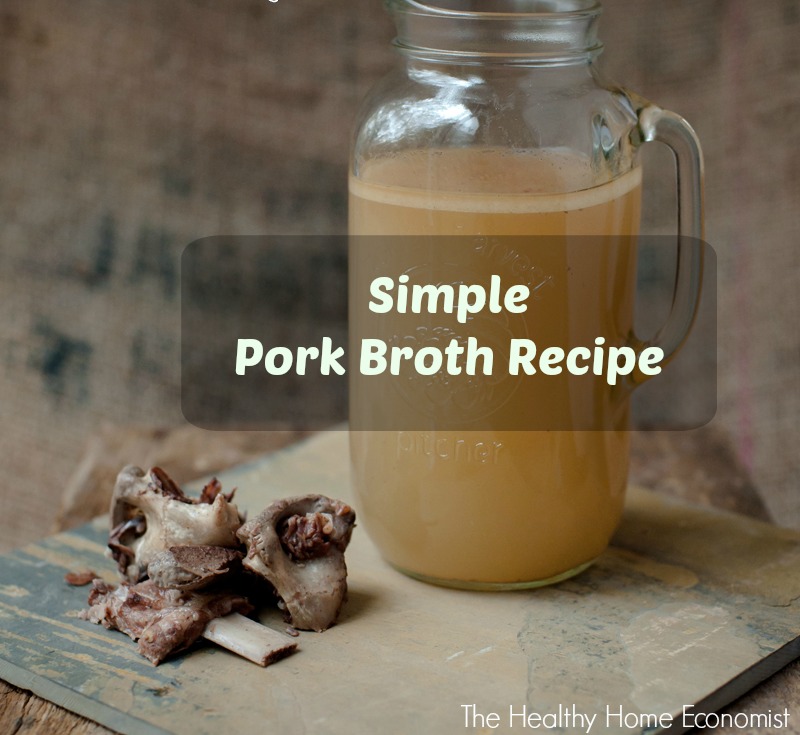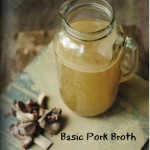 Making homemade bone broth is a crucial technique a Traditional Cook must master. Ideally, it is made at least once a week. Since quality bones are expensive, is pork broth an option? Most people have never considered it. Quality pastured pork at affordable prices is widely available in many communities. Let’s examine this question below.
Making homemade bone broth is a crucial technique a Traditional Cook must master. Ideally, it is made at least once a week. Since quality bones are expensive, is pork broth an option? Most people have never considered it. Quality pastured pork at affordable prices is widely available in many communities. Let’s examine this question below.
Health Requires Lots of Bone Broth – Why Not Pork?
I make a large pot of stock once or twice every week. Our family flies through quarts of it so quickly at mealtimes! A ready supply of gelatin and mineral rich broth in the freezer is also important when illness strikes. This nutrient rich food is a key player for rapid recovery without meds. This is especially true when a fever is involved.
Commercial Broth vs Homemade Broth
Getting sick and realizing there is no homemade bone broth is a devastating feeling, I can assure you! Simply running out to the store to pick up some canned soup or broth in a carton is not going to solve the problem. These industrially produced products even if organic are just water and MSG with little to no nutrient value and certainly no gelatin!
Even the properly made commercial bone broths available in recent years are not comparable to homemade. They are all watered down (every single brand I’ve tested). What’s worse, they are usually packaged in toxic plastic or plastic lined tetrapaks. The broth is boiling hot when it is poured into the containers if the product is shelf stable. Try it yourself. Put them in the refrigerator. They don’t gel like broth made at home does. The only brand worth buying is Epic bone broth in glass jars, but unfortunately it is still watered down.
Making your own broth has no substitute!
There is nothing worse than a tummy bug striking your children and knowing that a pot of gelatin rich stock that will halt the illness in its tracks is a full 24-48 hours away. Unless, of course, you can quickly source the right kind of fishheads, then a pot of stock can be ready in as little as 4 hours.
Pork Broth More Affordable than Most
With plenty of stock on hand for whatever your cooking or wellness needs might be, the next question is how to source quality bones at a price that is within a typical family’s food budget.
The highest quality pastured pork bones for making pork stock tend to cost between one half and three quarters as much as grassfed beef bones or pastured chicken in my experience, particularly if you source an entire hog.
Some might question how pork bones could make good pork broth given the fattiness of the meat. Culinary purists believe that soups and sauces made with fatty stock do not yield the best results. This problem is easily remedied by chilling pork stock in the refrigerator which allows the congealed pork fat to be removed from the top of the container of stock with a spoon.
If you’ve never tried pork broth or pork stock before, why don’t you give it a try? Here is a very simple and basic pork broth recipe to get you going. It is inspired by the beautiful book Beyond Bacon, Paleo Recipes that Respect the Whole Hog, by Stacy Toth and Matthew McCarry.
How to Make Pork Broth (Pork Stock)
The recipe for pork stock below makes about 2 quarts. Try it with your next batch! I’m sure you’re going to love it!


Pork Broth Recipe
How to make pork broth that is a affordable, nutritious, and delicious alternative to other more expensive stocks made with pastured poultry or grassfed beef bones.
Ingredients
- 3 lbs pastured pork bones
- 1 Tbl apple cider vinegar raw and unfiltered, preferably organic
- ground peppercorns
- sea salt
Instructions
-
Put all of the bones in a stockpot and add enough filtered water to cover.
Cook on high until the water comes to a boil and scum rises to the top. Cook for 5 minutes.
Dump the entire pot of water and refill with fresh filtered water, enough to cover the bones. Mix in the apple cider vinegar and bring the water to a boil once again.
Carefully skim off any foam that comes to the top. It should be minimal given that the water with most of the scum was dumped in the previous step.
Reduce heat and simmer on low for 9-24 hours.
Remove the pot from the heat, strain and taste. Add salt and pepper as needed. Let cool and then refrigerate in one or more airtight containers.
Skim the lard off the top of the chilled pork broth the following day and refrigerate. Reserve this delicious fat high in Vitamin D for cooking. This article plus video provides more information on how to render lard.
Use the clarified pork stock as the base for soups and sauces the same as you would use chicken or beef stock.
Sarah, The Healthy Home Economist








Lori, I can my broth because the freezer is full. Don’t know what the change in nutritional profile is but it is still better than throwing it away. We use broth for making soup, etc and it tastes good. I would say , go for it. Clear broth 15 lbs for 25 minutes in the pressure cooker. Canning meat takes 90 minutes according to the book . Seems like a long time but oh well.
Does anyone can their broth? I’ve run out of freezer space. This question was asked earlier, but I didn’t see an answer.
Yes, meat stock can be canned, but you need a pressure canner to do it. I personally have never had any sort of stock stick around ling enough that storage becomes an issue…
nchfp.uga.edu/how/can_05/stock_broth.html
I’ve never tried making stock before but when I already have kids, I always make this. I usually make beef stock and the kids love it. This time, I will make pork stock. BTW, thanks for the link! 😉
Katrina, I would get all of the pig that they don’t put in packages for something else. the head, feet, backbone, tail etc. everything that they would “normally” throw away and cook it all down. I skinned out all the parts and cooked them down and got lots of stock for “free”
Ok- Thank You.
I would also like to know about using a pressure cooker to make stock. Is it a good thing or not? It is so much easier.
I think you are damaging the good stuff in the stock by cooking it so quickly. but pressure cooked stock may be better than no stock. not sure. i like the crockpot because i don’t have to watch it. it takes longer but my actual hands on time is very little.
Pretty sure I’ve read it can be ok to use the pressure cooker. If the stock still gels, it should be ok. We live in the desert, so in the summer, the slow cook method makes the house too hot and the pressure cooker allows us to have broth when we otherwise wouldn’t make it. I love the pork broth, it’s great in beans. I remove the fat too and find that it may have too strong a flavor in some dishes so, I use part broth and part water in my beans.
I have been doing a lot of reading on the virtues of the pressure cooker. My mom and aunties (depression era/WWII “veterans”) who grew and made EVERYTHING from scratch used them constantly. I have used mine for about a year, and find that it is actually BETTER than open pot or crock pot stocks because it extracts way more of the flavor and collagens that give nearly jelly-like consistency when cooled and an incredible “mouth-feel” when used in recipes. It is also much faster, I can make 2 or 3 different batches of stocks (even bone stocks) in a day. (GREAT chicken stock in under an hour and a half – cutting up the chicken to labeling the containers…)
I am getting 1/2 a pastured pig next month- it goes to the butcher the end of this month and I will be able to let them know the parts I want to keep. What kind of bones do I ask for?
ask for everything that doesn’t go in the other packages. Bones, head if you can get it, feet, fat (for rendering lard), everything. Did this with our pig this year and brought home a box with 30 pounds of trimmings which did not include the head or feet. they were extra. Makes great broth, and beautiful lard.
love your site and learn so much! what does everybody freeze their stock in? every time i try to freeze in mason jars they break and then i am so sad…..does anybody have a trick out there? i know it needs to cool before freezing, which i’ve done before…..don’t fill to the top, don’t cover too tightly……am i crazy? how do you do it?
also, i have canned stock before to be shelf stable……is that okay to do? or does it destroy good stuff?
would absolutely LOVE an answer.
thank you!!!
I too have been careful to not overfill my jars for freezing and still had them break.
Such a drag when there is breakage and all that work and nutrition goes into the trash! I now only use canning jars (as opposed to recycled pasta sauce jars) and they don’t break.
I know this is not the healthiest or most sustainable option, but I have resorted to using quart-sized freezer bags. I have had trouble with glass breakage in my freezer (even with canning jars) so I don’t like to use it for that application anymore. The quart bags work great because they hold 4 cups of stock, they lie flat and take us less room in my tiny freezer. However, I feel they are safest when I allow the stock to cool completely before filling them. I don’t defrost the stock in the bags either, I cut the bag open and pop the stock cube in a cooking pot or bowl.
Try the pint-and-a-half, straight-sided Ball jars, available at most Ace Hardware stores and other places. There’s a fill line that’s about an inch from the top, and no “shoulders” to trap the expanding broth as it freezes.
I am usually only freezing in small portions, but this works for me. I pour stock/broth/any liquid I want to save into a regular bowl; just make sure it is smaller at the bottom and wider at the top by a good difference. I pour the liquid in, freeze the whole bowl somewhere safe in the freezer. Once it forms the shape of the bowl, I let it sit out for about 5 minutes, then pop/slide it out of the bowl into a ziploc bag and put back in the freezer. (Sometimes, I use a butter knife to loosen the edges). This way, I can pull it out in smaller portions (the blocks stay frozen individually) and I can reuse the bag over and over.
I do the same thing. I use little plastic bowls. Yogurt containers, even ice cube trays sometimes. Since the stock is not hot when I pour it in, I don’t think it can leach much of anything harmful from the plastic. I’d love to have all glass but it takes time to transition. Anyway, once frozen I pop them out of the container and put them all in a ziplock bag together and label it. Anything from an ice cube which is 2 Tablespoons, to a yogurt container, which is about 2 cups.
Excellent idea. My freezer is stuffed with bones, dog bones, dog food, venison, hog, chickens, etc. and sometimes we just don’t have enough room to put containers in. Thanks.
I use Gladware square containers – sandwich size I guess – they hold over 3 cups. They stack well in the freezer. No more avalanches like when I used bags or breakage when I used glass jars. Just make sure the stock is well cooled and no issue with plastic.
Aimee,
I freeze in jars all the time! One very important thing is to make sure any bevel or tapering of the glass is not reached by the broth. You must leave also some room, like 1/4 of an inch or more, to allow the broth to expand upwards. I also stand all my jars until they are frozen. I cool before freezing. I have been doing for years now. A stand up freezer makes it easier if you do a lot. I have done in a regular freezer.
No Canning kills too much of the nutrition in broth.
re canning jars breaking in the freezer. the reason is they sometimes do not have enough space for the liquid to expand into, even if you provide room at the top of the jar.. the way to deal with that is to place the jar, with the cooled stock, upright in the freezer and just rest the metal lid on the jar. do not put on the metal ring. or if you are using regular jars, just place the lid lightly on the jar. do not screw it down.
when the stock freezes it can just push the metal lid up if more space for the freezing stock is needed.
if it does this I take the jar out of the freezer and with a warm knife slice off the excess frozen broth. then I replace the lid and add the metal ring. don’t do this too early. wait a day or 2 to be sure the broth is completely frozen, otherwise the jar might still crack.
I recently had a canning jar break when it was on a shelf. It had candy in it and was not even heavy. The bottom of the jar broke when I picked it up. I don’t understand it at all. Any thoughts?
For larger quantities (2 and 4 cup portions) I use Snapware (plastic) because it seals well and is BPA free. I have also been filling muffin tins, freezing, then popping the frozen muffin sized pieces of stock (~1/2 C. each) and storing them in a labeled freezer bag in the upstairs (small) freezer for immediate use – so convenient to simply grab a 1/2 cup when needed…
I refrigerate broth in cleaned, reused jars first. Following morning, skim off congealed fat. Then put them in freezer. Never has a glass jar broken. Perhaps it’s the night in fridge (acclimating to cold) or leaving plenty of room for expansion? I use regular jars, like from pickles or sauces that were made for liquids.
Sarah,
I noticed you add vinegar when you cook stock. Is the vinegar for flavor or is there another reason for adding the vinegar?
Vinegar helps leech the minerals from the bones into the broth. Standard cooking technique.
Sarah, can you provide any insights about the recommendation to dump the water and refill? Would this be beneficial regardless of how the pig was raised? Also, is skimming the fat optional? Do you like to use the skimmed fat like you would rendered lard, or do you discard it for some reason?
Hi Beth, dumping the water just makes it easier to remove any foam/scum with pork broth. You can just skim if you like.
BLEKKKKK
Pork is not food.
Pork is a staple food for Southern Japan which (and still does today) has one of the longest lived and healthiest on earth.
Have you gave thought to the fact that these animals are pumped with so many antibiotics – that is what actually heals you!!! Disgusting! Also all of the gmo feed the pig eats is straight pesticides.
Did you read the post? I buy my pork from pastured pork farmers and recommend the same for my readership. Pastured pigs are never shot up with drugs and antibiotics and freely graze and roam. They also don’t get GMO feed.
It is very easy to find naturally raised, pastured pork, almost as easy as spouting off on the internet about something you know nothing about. One of the guys my husband works with raises show hogs for the 4H and FFA kids, and we always buy a couple from him to have butchered at our local butcher shop.
if pork is not food, then what is a pig’s function on earth? honestly, there is nothing else they do.
They are good for sneaking out of their pens and munching all the nasty cabbages your parents were planninng on feeding you 🙂
You should have more respect for the animals lives in which you find nourishment!